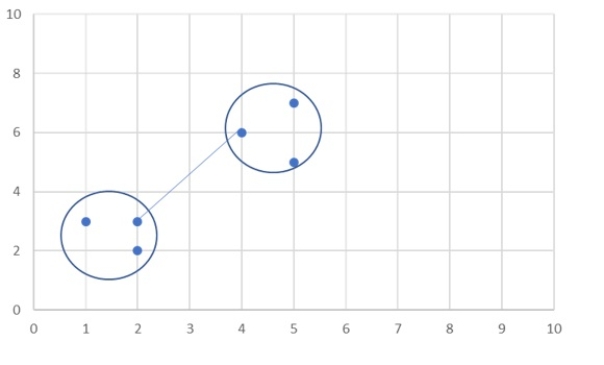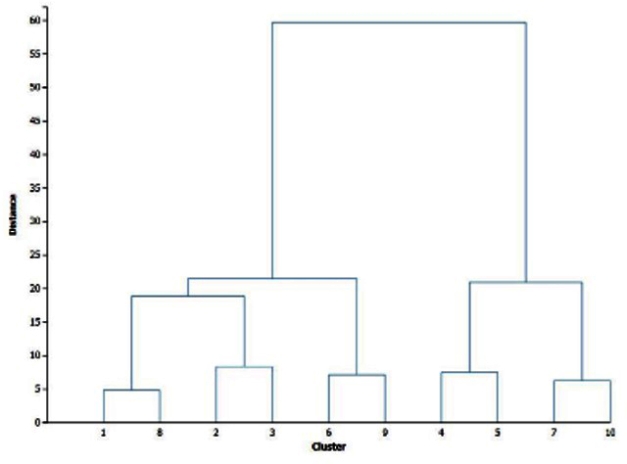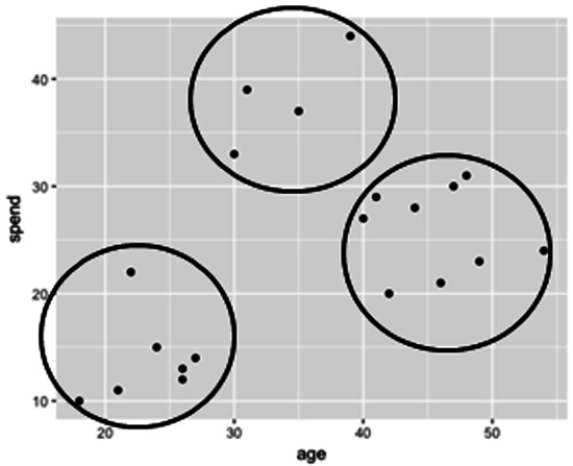Deck 11: Unsupervised Data Mining
Question
Question
Question
Question
Question
Question
Question
Question
Question
Question
Question
Question
Question
Question
Question
Question
Question
Question
Question
Question
Question
Question
Question
Question
Question
Question
Question
Question
Question
Question
Question
Question
Question
Question
Question
Question
Question
Question
Question
Question
Question
Question
Question
Question
Question
Question
Question
Question
Question
Question
Question
Question
Question

Unlock Deck
Sign up to unlock the cards in this deck!
Unlock Deck
Unlock Deck
1/53
Play
Full screen (f)
Deck 11: Unsupervised Data Mining
1
Which method uses the farthest distance between a pair of observations that do not belong to the same cluster?
A) The single linkage method
B) The complete linkage method
C) The centroid method
D) The average linkage method
A) The single linkage method
B) The complete linkage method
C) The centroid method
D) The average linkage method
The complete linkage method
2
In the following AGNES algorithm, what type of linkage distance method is being displayed? 
A) The centroid method
B) The single linkage method
C) The complete linkage method
D) No linkage method is shown

A) The centroid method
B) The single linkage method
C) The complete linkage method
D) No linkage method is shown
The single linkage method
3
When using R for Agglomerative Clustering, the plot function is used to create the dendrogram as well as a banner plot. What function is used to split these results into distinct clusters?
A) aResult
B) data.frame
C) cutree
D) view
A) aResult
B) data.frame
C) cutree
D) view
cutree
4
The following results are a subset of a study on the demographics of a city population. Participants were asked to respond if male (1) or female (0), current annual salary, and if they were raised in a suburb (1) or in a city (0). Based on the hierarchical clustering results, which of the following is not a valid observation that can be made? 
A) Cluster 3 has the most observations of participants that grew up in the city.
B) Cluster 1 has a 48% male population with 49% being raised in the suburbs.
C) Cluster 4 has the highest average salary, with 67% of participants being female.
D) Cluster 2 has the most participants in the cluster with over half being raised in a city.

A) Cluster 3 has the most observations of participants that grew up in the city.
B) Cluster 1 has a 48% male population with 49% being raised in the suburbs.
C) Cluster 4 has the highest average salary, with 67% of participants being female.
D) Cluster 2 has the most participants in the cluster with over half being raised in a city.

Unlock Deck
Unlock for access to all 53 flashcards in this deck.
Unlock Deck
k this deck
5
The following results are a subset of a study on the demographics of a city population. Participants were asked to respond if male (1) or female (0), current annual salary, and if they were raised in a suburb (1) or in a city (0). Based on the hierarchical clustering results, which of the following is not a valid observation that can be made? 
A) Cluster 3 has the most observations of participants that grew up in the city.
B) Cluster 1 has a 48% male population with 49% being raised in the suburbs.
C) Cluster 4 has the highest average salary, with 53% of participants being female.
D) Cluster 2 has the most participants in the cluster with over half being raised in a city.

A) Cluster 3 has the most observations of participants that grew up in the city.
B) Cluster 1 has a 48% male population with 49% being raised in the suburbs.
C) Cluster 4 has the highest average salary, with 53% of participants being female.
D) Cluster 2 has the most participants in the cluster with over half being raised in a city.

Unlock Deck
Unlock for access to all 53 flashcards in this deck.
Unlock Deck
k this deck
6
In the k-Means Clustering Method, there is a general process of how k-means clustering algorithm can be classified. Which one of the following is not one of the general processes?
A) Specify the k value
B) Randomly assign k observations to its nearest cluster center
C) Calculate the cluster centroids
D) Reassign each observation to the nearest observation point
A) Specify the k value
B) Randomly assign k observations to its nearest cluster center
C) Calculate the cluster centroids
D) Reassign each observation to the nearest observation point

Unlock Deck
Unlock for access to all 53 flashcards in this deck.
Unlock Deck
k this deck
7
Using the following dendrogram created by using the k-means method, identify the number k was given to form the clusters present. 
A) 5
B) 8
C) 9
D) 10

A) 5
B) 8
C) 9
D) 10

Unlock Deck
Unlock for access to all 53 flashcards in this deck.
Unlock Deck
k this deck
8
The marketing department is examining the data pulled from the retail stores over the month of December. In this time period, three items are of interest, Sound Bars, LED under counter lights, and shelving units.
- In researching if two of the items are purchased, if the third will be also, the following confidence level was calculated at 0.625, with an expected confidence of 0.20. Calculate the lift ratio.
A) 0.1250
B) 3.125
C) 0.3200
D) 0.425
- In researching if two of the items are purchased, if the third will be also, the following confidence level was calculated at 0.625, with an expected confidence of 0.20. Calculate the lift ratio.
A) 0.1250
B) 3.125
C) 0.3200
D) 0.425

Unlock Deck
Unlock for access to all 53 flashcards in this deck.
Unlock Deck
k this deck
9
The marketing department is examining the data pulled from the retail stores over the month of December. In this time period, three items are of interest, Sound Bars, LED under counter lights, and shelving units.
-In researching if two of the items are purchased, if the third will be also, the following confidence level was calculated at 0.575, with an expected confidence of 0.10. Calculate the lift ratio.
A) 0.0575
B) 5.75
C) 0.6389
D) 0.475
-In researching if two of the items are purchased, if the third will be also, the following confidence level was calculated at 0.575, with an expected confidence of 0.10. Calculate the lift ratio.
A) 0.0575
B) 5.75
C) 0.6389
D) 0.475

Unlock Deck
Unlock for access to all 53 flashcards in this deck.
Unlock Deck
k this deck
10
Of 8,000 grocery store transactions, 795 have been identified as having coffee, ice cream, and chips as part of the same transaction. Calculate the support of the association rule.
A) 10.063
B) 0.0994
C) 7.95
D) 0.795
A) 10.063
B) 0.0994
C) 7.95
D) 0.795

Unlock Deck
Unlock for access to all 53 flashcards in this deck.
Unlock Deck
k this deck
11
Of 10,000 grocery store transactions, 895 have been identified as having coffee, ice cream, and chips as part of the same transaction. Calculate the support of the association rule.
A) 11.173
B) 0.0895
C) 8.95
D) 0.895
A) 11.173
B) 0.0895
C) 8.95
D) 0.895

Unlock Deck
Unlock for access to all 53 flashcards in this deck.
Unlock Deck
k this deck
12
Martin wants to understand the strength of association among toilet paper, milk, and eggs. Of 8,000 transactions, the number of transactions including antecedent is 1,710 whereas the number of transactions including both antecedent and consequent transactions is 750. Calculate the confidence.
A) 0.3075
B) 0.2138
C) 0.4386
D) 0.0938
A) 0.3075
B) 0.2138
C) 0.4386
D) 0.0938

Unlock Deck
Unlock for access to all 53 flashcards in this deck.
Unlock Deck
k this deck
13
Martin wants to understand the strength of association among toilet paper, milk, and eggs. Of 5,000 transactions, the number of transactions including antecedent is 1,520 whereas the number of transactions including both antecedent and consequent transactions is 690. Calculate the confidence.
A) 0.4420
B) 0.3040
C) 0.4539
D) 0.1380
A) 0.4420
B) 0.3040
C) 0.4539
D) 0.1380

Unlock Deck
Unlock for access to all 53 flashcards in this deck.
Unlock Deck
k this deck
14
Of 6,200 total transactions, 1,470 transactions are the number of consequents, confidence equals 0.5276. Calculate the expected confidence.
A) 0.24
B) 2.37
C) 3,271
D) 0.7629
A) 0.24
B) 2.37
C) 3,271
D) 0.7629

Unlock Deck
Unlock for access to all 53 flashcards in this deck.
Unlock Deck
k this deck
15
Of 5,000 total transactions, 1,400 transactions are the number of consequents, confidence equals 0.5203. Calculate the expected confidence.
A) 0.28
B) 2.80
C) 2,601
D) 0.6919
A) 0.28
B) 2.80
C) 2,601
D) 0.6919

Unlock Deck
Unlock for access to all 53 flashcards in this deck.
Unlock Deck
k this deck
16
Using the following transactions, what is the frequency distribution? 
A) Latte-3%; Scone-5%; Muffin-7%; Egg-4%; Espresso-2%; Coffee-1%; Fruit Cup-3%; Cookie-2%
B) Latte-1/5; Scone-1/5; Muffin-1/7; Egg-1/4; Espresso-1/2; Coffee-1/2; Fruit Cup-1/3; Cookie-1/3
C) Latte-1; Scone-2; Muffin-4; Egg-3; Espresso-5; Coffee-6; Fruit Cup-7; Cookie-21
D) Latte-4; Scone-5; Muffin-7; Egg-4; Espresso-2; Coffee-2; Fruit Cup-3; Cookie-2

A) Latte-3%; Scone-5%; Muffin-7%; Egg-4%; Espresso-2%; Coffee-1%; Fruit Cup-3%; Cookie-2%
B) Latte-1/5; Scone-1/5; Muffin-1/7; Egg-1/4; Espresso-1/2; Coffee-1/2; Fruit Cup-1/3; Cookie-1/3
C) Latte-1; Scone-2; Muffin-4; Egg-3; Espresso-5; Coffee-6; Fruit Cup-7; Cookie-21
D) Latte-4; Scone-5; Muffin-7; Egg-4; Espresso-2; Coffee-2; Fruit Cup-3; Cookie-2

Unlock Deck
Unlock for access to all 53 flashcards in this deck.
Unlock Deck
k this deck
17
Using the following transactions, what is the frequency distribution? 
A) Latte-4%; Scone-4%; Muffin-7%; Egg-3%; Espresso-2%; Coffee-2%; Fruit Cup-3%; Cookie-2%
B) Latte-1/6; Scone-1/4; Muffin-1/7; Egg-1/3; Espresso-1/2; Coffee-1/2; Fruit Cup-1/3; Cookie-1/2
C) Latte-1; Scone-2; Muffin-4; Egg-3; Espresso-5; Coffee-6; Fruit Cup-7; Cookie-8
D) Latte-5; Scone-4; Muffin-7; Egg-3; Espresso-2; Coffee-3; Fruit Cup-3; Cookie-2

A) Latte-4%; Scone-4%; Muffin-7%; Egg-3%; Espresso-2%; Coffee-2%; Fruit Cup-3%; Cookie-2%
B) Latte-1/6; Scone-1/4; Muffin-1/7; Egg-1/3; Espresso-1/2; Coffee-1/2; Fruit Cup-1/3; Cookie-1/2
C) Latte-1; Scone-2; Muffin-4; Egg-3; Espresso-5; Coffee-6; Fruit Cup-7; Cookie-8
D) Latte-5; Scone-4; Muffin-7; Egg-3; Espresso-2; Coffee-3; Fruit Cup-3; Cookie-2

Unlock Deck
Unlock for access to all 53 flashcards in this deck.
Unlock Deck
k this deck
18
Use the proportion of the following transactions that contain both Latte and Scone and calculate the Support of the association rule. 
A) 0.25
B) 0.70
C) 0.30
D) 0.75

A) 0.25
B) 0.70
C) 0.30
D) 0.75

Unlock Deck
Unlock for access to all 53 flashcards in this deck.
Unlock Deck
k this deck
19
Use the proportion of the following transactions that contain both Latte and Scone and calculate the Support of the association rule. 
A) 0.25
B) 0.70
C) 0.30
D) 0.75

A) 0.25
B) 0.70
C) 0.30
D) 0.75

Unlock Deck
Unlock for access to all 53 flashcards in this deck.
Unlock Deck
k this deck
20
Carmen pulled transactions from the month of March to see if there is an association between coffee and breakfast sandwich purchases. After running through confidence and expected confidence calculations, she calculated the lift ratio at 1.52. What association does a calculated lift ratio of 1.52 reflect?
A) A lift ratio of 1.52 is over 1, indicating a weak association between coffee and breakfast sandwiches.
B) 1.52 implies that identifying a person who purchases coffee and a breakfast sandwich is 52% better than guessing that a random person will purchase a breakfast sandwich.
C) 1.52 implies that 52% of consumers will purchase coffee and not a breakfast sandwich.
D) The lift ratio cannot determine the association between purchases.
A) A lift ratio of 1.52 is over 1, indicating a weak association between coffee and breakfast sandwiches.
B) 1.52 implies that identifying a person who purchases coffee and a breakfast sandwich is 52% better than guessing that a random person will purchase a breakfast sandwich.
C) 1.52 implies that 52% of consumers will purchase coffee and not a breakfast sandwich.
D) The lift ratio cannot determine the association between purchases.

Unlock Deck
Unlock for access to all 53 flashcards in this deck.
Unlock Deck
k this deck
21
Using R, which function is used to conduct association rule analysis?
A) itemFrequency
B) apriori
C) inspect
D) read.transaction
A) itemFrequency
B) apriori
C) inspect
D) read.transaction

Unlock Deck
Unlock for access to all 53 flashcards in this deck.
Unlock Deck
k this deck
22
Eva is trying to figure out the total number of possible combinations for 130 inventory items. Calculate the number for Eva.
A) 3.80887E + 61 possible combinations
B) 1.126E + 124 possible combinations
C) 1.06112E + 62 possible combinations
D) 1.26780E + 251 possible combinations
A) 3.80887E + 61 possible combinations
B) 1.126E + 124 possible combinations
C) 1.06112E + 62 possible combinations
D) 1.26780E + 251 possible combinations

Unlock Deck
Unlock for access to all 53 flashcards in this deck.
Unlock Deck
k this deck
23
Eva is trying to figure out the total number of possible combinations for 50 inventory items. Calculate the number for Eva.
A) 2.57689E + 23 possible combinations
B) 5.15378E + 47 possible combinations
C) 7.17898E + 23 possible combinations
D) 2.65614E + 98 possible combinations
A) 2.57689E + 23 possible combinations
B) 5.15378E + 47 possible combinations
C) 7.17898E + 23 possible combinations
D) 2.65614E + 98 possible combinations

Unlock Deck
Unlock for access to all 53 flashcards in this deck.
Unlock Deck
k this deck
24
Martin wants to use Gower's coefficient to compute the distance for each variable and to convert it into a [0,1] scale. What analysis package will he use to run the analysis?
A) Analytic Solver only
B) Analytic Solver & R
C) R only
D) Excel
A) Analytic Solver only
B) Analytic Solver & R
C) R only
D) Excel

Unlock Deck
Unlock for access to all 53 flashcards in this deck.
Unlock Deck
k this deck
25
Of the following options, which is not accurate for clustering?
A) Euclidean distance or Manhattan distance measures for numerical variables and matching.
B) AGNES takes each observation in the data initially and forms its own cluster.
C) Hierarchical clustering commonly follows agglomerative and divisive clustering.
D) Cluster analysis is where small amounts of data are organized against larger statistical sets.
A) Euclidean distance or Manhattan distance measures for numerical variables and matching.
B) AGNES takes each observation in the data initially and forms its own cluster.
C) Hierarchical clustering commonly follows agglomerative and divisive clustering.
D) Cluster analysis is where small amounts of data are organized against larger statistical sets.

Unlock Deck
Unlock for access to all 53 flashcards in this deck.
Unlock Deck
k this deck
26
The use of error sum of squares to measure the loss of information that occurs when observations are clustered describes which method?
A) The centroid method
B) The complete linkage method
C) The average linkage method
D) Ward's method
A) The centroid method
B) The complete linkage method
C) The average linkage method
D) Ward's method

Unlock Deck
Unlock for access to all 53 flashcards in this deck.
Unlock Deck
k this deck
27
k-means clustering algorithm can be summarized as all of the following except for
A) Can be either numerical or character variables.
B) Specify the k value.
C) Randomly assign k observations as cluster centers.
D) Assign each observation to its nearest cluster center.
A) Can be either numerical or character variables.
B) Specify the k value.
C) Randomly assign k observations as cluster centers.
D) Assign each observation to its nearest cluster center.

Unlock Deck
Unlock for access to all 53 flashcards in this deck.
Unlock Deck
k this deck
28
Tosh Marketing Group wants to identify customers who are likely to purchase high-end appliances for a new marketing campaign. After collecting data from recent customers, the following plot was created showing age and spend variables with 3 distinct clusters. Which cluster offers the best target with the highest spend for marketing materials? 
A) The lower-left cluster reflects the younger age range and should be the target of the marketing.
B) The upper-middle cluster reflects a higher spend for appliances versus the lower-left and far-right clusters.
C) The far-right cluster is in the middle and the highest spend for appliances.
D) Both the upper-middle cluster and the lower-left cluster are the highest spends for appliances.

A) The lower-left cluster reflects the younger age range and should be the target of the marketing.
B) The upper-middle cluster reflects a higher spend for appliances versus the lower-left and far-right clusters.
C) The far-right cluster is in the middle and the highest spend for appliances.
D) Both the upper-middle cluster and the lower-left cluster are the highest spends for appliances.

Unlock Deck
Unlock for access to all 53 flashcards in this deck.
Unlock Deck
k this deck
29
In reviewing purchases at Costco on a given Saturday, 645 transactions out of 1,250 included toilet paper, detergent, and clothing or {toilet paper, detergent} => {clothing}. Calculate the support of the association rule.
A) 0.516
B) 1.516
C) 1,250
D) 6.45
A) 0.516
B) 1.516
C) 1,250
D) 6.45

Unlock Deck
Unlock for access to all 53 flashcards in this deck.
Unlock Deck
k this deck
30
In reviewing purchases at Costco on a given Saturday, 385 transactions out of 1,000 included toilet paper, detergent, and clothing or {toilet paper, detergent} => {clothing}. Calculate the support of the association rule.
A) 0.385
B) 1.385
C) 1,000
D) 3.85
A) 0.385
B) 1.385
C) 1,000
D) 3.85

Unlock Deck
Unlock for access to all 53 flashcards in this deck.
Unlock Deck
k this deck
31
Toilet paper and detergent are the antecedent, where 950 of the 6,500 transactions include both items. Of the overall 6,500 transactions, 126 include toilet paper, detergent, and the consequent of clothing. Using the association rule, what is the confidence?
A) 0.0194
B) 18.415
C) 0.146
D) 0.1326
A) 0.0194
B) 18.415
C) 0.146
D) 0.1326

Unlock Deck
Unlock for access to all 53 flashcards in this deck.
Unlock Deck
k this deck
32
Toilet paper and detergent are the antecedent, where 890 of the 10,000 transactions include both items. Of the overall 10,000 transactions, 234 include toilet paper, detergent, and the consequent of clothing. Using the association rule, what is the confidence?
A) 0.0234
B) 20.826
C) 0.089
D) 0.2629
A) 0.0234
B) 20.826
C) 0.089
D) 0.2629

Unlock Deck
Unlock for access to all 53 flashcards in this deck.
Unlock Deck
k this deck
33
Costco is known for lower prices for bulk items. After calculating the support and confidence values for {toilet paper} => {avocados}, there appears to be a strong association because a large percentage of customers purchase these items. However, to avoid assuming the strength of association, what option should be done to confirm the strength of the association?
A) Review the transactions for accuracy
B) Rerun the confidence
C) Calculate the lift ratio
D) If the support and confidence are strong then no need to run anything more
A) Review the transactions for accuracy
B) Rerun the confidence
C) Calculate the lift ratio
D) If the support and confidence are strong then no need to run anything more

Unlock Deck
Unlock for access to all 53 flashcards in this deck.
Unlock Deck
k this deck
34
Based on the following table, what is the frequency distribution of the most purchased item? 
A) bread
B) cheese
C) milk
D) yogurt

A) bread
B) cheese
C) milk
D) yogurt

Unlock Deck
Unlock for access to all 53 flashcards in this deck.
Unlock Deck
k this deck
35
Based on the following table, what is the frequency distribution of the most purchased item? 
A) bread
B) cheese
C) milk
D) yogurt

A) bread
B) cheese
C) milk
D) yogurt

Unlock Deck
Unlock for access to all 53 flashcards in this deck.
Unlock Deck
k this deck
36
Based on the following table, what is the proportion of the transactions that include both milk and bread? 
A) 0.80
B) 0.60
C) 0.20
D) 0.40

A) 0.80
B) 0.60
C) 0.20
D) 0.40

Unlock Deck
Unlock for access to all 53 flashcards in this deck.
Unlock Deck
k this deck
37
Based on the following table, what is the proportion of the transactions that include both milk and bread? 
A) 0.80
B) 0.60
C) 0.20
D) 0.40

A) 0.80
B) 0.60
C) 0.20
D) 0.40

Unlock Deck
Unlock for access to all 53 flashcards in this deck.
Unlock Deck
k this deck
38
The Corner Market is using 1,750 transactions on item purchases for analysis. Based on initial results, the manager noticed eggs and potato chips were frequently in the same transactions. After calculating the confidence and the expected confidence on the data, 0.44 and 0.61 respectively, they want to run a lift ratio to ensure there is a positive association. Calculate the lift ratio and determine if the association is positive or negative.
A) 0.7213, positive number, positive association
B) 0.7213, under one, negative association
C) 1.386, over one, positive association
D) -1.386, negative number, negative association
A) 0.7213, positive number, positive association
B) 0.7213, under one, negative association
C) 1.386, over one, positive association
D) -1.386, negative number, negative association

Unlock Deck
Unlock for access to all 53 flashcards in this deck.
Unlock Deck
k this deck
39
The Corner Market is using 2,500 transactions on item purchases for analysis. Based on initial results, the manager noticed eggs and potato chips were frequently in the same transactions. After calculating the confidence and the expected confidence on the data, 0.54 and 0.62 respectively, they want to run a lift ratio to ensure there is a positive association. Calculate the lift ratio and determine if the association is positive or negative.
A) 0.871, positive number, positive association
B) 0.871, under one, negative association
C) 1.148, over one, positive association
D) -1.148, negative number, negative association
A) 0.871, positive number, positive association
B) 0.871, under one, negative association
C) 1.148, over one, positive association
D) -1.148, negative number, negative association

Unlock Deck
Unlock for access to all 53 flashcards in this deck.
Unlock Deck
k this deck
40
Sara is a marketing analysis manager for a top cereal producer. Part of her job is to review product sales to grocery chains and if the contracted product shelf placement is the optimal location to maximize sales. Because of the large data sets, she is only interested in creating a small number of clusters to view the results. What type of clustering method would work best?
A) hierarchical clustering
B) agglomerative clustering
C) divisive clustering
D) k-means clustering
A) hierarchical clustering
B) agglomerative clustering
C) divisive clustering
D) k-means clustering

Unlock Deck
Unlock for access to all 53 flashcards in this deck.
Unlock Deck
k this deck
41
Amazon uses searches and items purchased to create future product marketing recommendations. Additionally, demographics drive additional potential products to be recommended. To do this, what type of market basket analysis is used?
A) Information Rule
B) Supervised Data Analysis
C) Association Rule
D) k-mean
A) Information Rule
B) Supervised Data Analysis
C) Association Rule
D) k-mean

Unlock Deck
Unlock for access to all 53 flashcards in this deck.
Unlock Deck
k this deck
42
Using R, what function is used to view the rules by their lift ratios?
A) lookup
B) apriori
C) rules
D) sort
A) lookup
B) apriori
C) rules
D) sort

Unlock Deck
Unlock for access to all 53 flashcards in this deck.
Unlock Deck
k this deck
43
In cluster analysis, measures are used to form clusters. However, when large data sets are imported into R, sometimes the variables do not share the same format. To overcome this, you standardize the data using the _____ function.
A) score
B) scale
C) standard
D) dist
A) score
B) scale
C) standard
D) dist

Unlock Deck
Unlock for access to all 53 flashcards in this deck.
Unlock Deck
k this deck
44
The forming of groups into internally homogeneous groups where each has a unique characteristic, different from other groups, is called cluster analysis.

Unlock Deck
Unlock for access to all 53 flashcards in this deck.
Unlock Deck
k this deck
45
The most commonly used approach for hierarchical clustering is divisive clustering.

Unlock Deck
Unlock for access to all 53 flashcards in this deck.
Unlock Deck
k this deck
46
When using k-means clustering, the number of clusters are specified at the end of the analysis to remove overlapping clusters.

Unlock Deck
Unlock for access to all 53 flashcards in this deck.
Unlock Deck
k this deck
47
When evaluating large data sets, it is customary to cluster large data sets using the k-means to reduce the computation of measures during each iteration compared to hierarchical clustering methods.

Unlock Deck
Unlock for access to all 53 flashcards in this deck.
Unlock Deck
k this deck
48
When using R, after the data is imported, set.seed function is used to set the random seed and the k function sets the k parameters to preselect the number of clusters.

Unlock Deck
Unlock for access to all 53 flashcards in this deck.
Unlock Deck
k this deck
49
In understanding the association rules, it is best to think of them as an If-Then statement.

Unlock Deck
Unlock for access to all 53 flashcards in this deck.
Unlock Deck
k this deck
50
Under the association rule, a lift ratio between 0 and 1 indicates a positive association.

Unlock Deck
Unlock for access to all 53 flashcards in this deck.
Unlock Deck
k this deck
51
If-Then logical statements are constructed with the If portion being the consequent and the Then being the antecedent.

Unlock Deck
Unlock for access to all 53 flashcards in this deck.
Unlock Deck
k this deck
52
The Ward's method is the use of a different algorithm to minimize the dissimilarity within clusters by using error sum of squares.

Unlock Deck
Unlock for access to all 53 flashcards in this deck.
Unlock Deck
k this deck
53
A dendrogram allows for a visual inspection of the clustering results.

Unlock Deck
Unlock for access to all 53 flashcards in this deck.
Unlock Deck
k this deck



